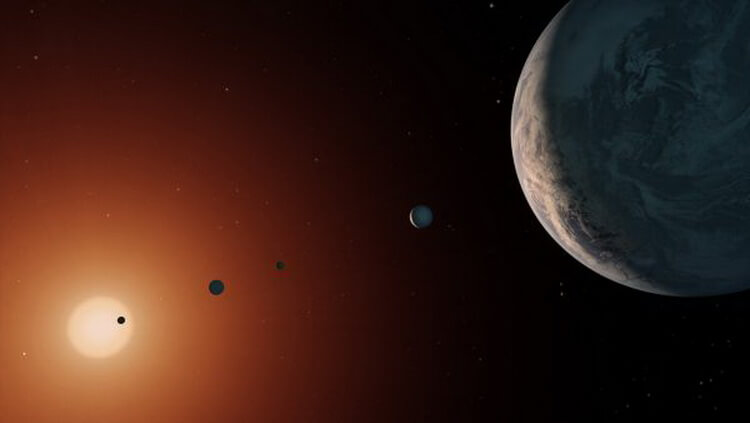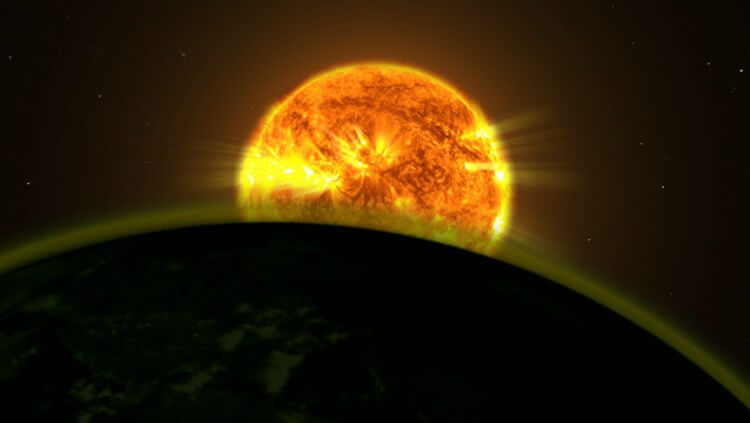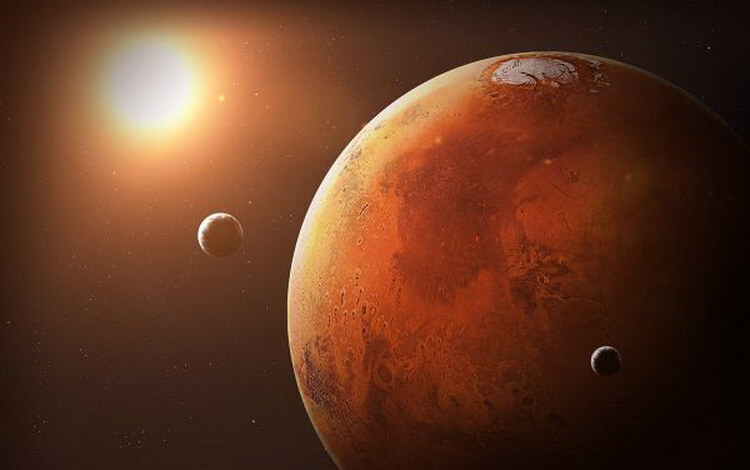
Over the past ten years the mankind has greatly accelerated the pace of the search for planets outside the Solar system. No, on the one hand, this is certainly wonderful – a lot of new scientific information, but what are we gonna do with all these planets? Of course, now we have no doubt that one day humanity will be an interplanetary species, but these times still need to live. So what are we to do in the meantime? Do just wait or still should start to prepare for now?
Such are the emerging issues in scientific and pseudo-scientific environment lead to a very interesting and ambitious suggestions. This proposal, for example, is the project Blue, in which it is proposed to establish a space telescope whose sole task will be to direct observation and study of any of the planets in the constellation alpha Centauri, who will become the first goal of interstellar flight. Or, for example, Breakthrough Starshot is a joint initiative of the famous theoretical physicist Stephen Hawking and Russian billionaire Yuri Milner who set themselves the task of sending to alpha Centauri spacecraft nanoscale “riding” on a very powerful laser beam that can get there in just 20 years. But perhaps the most daring and ambitious of the proposals lately is “the Genesis Project”, which has set itself the task of settling the planets outside of the Solar system “seeds of life”.
The author of the proposal is Dr. Claudius Gros, a theoretical physicist from the Institute for theoretical physics at Frankfurt University, Johann Wolfgang Goethe. In 2016, Gros published an article describing how it would be possible to stimulate the proliferation of microbial life on the “partially habitable exoplanets” (planets that can support life, but not able to generate) with the help of robotic missions, in which these planets will be sent a special gene factory.

The purpose of the “Project Genesis” is to check “partially habitable exoplanets” seeds of life, thus initiating a new evolution
Not so long ago the portal Universe Today wrote about a recent study by Dr. Gros, in which he proposed to use as the system slowing down an interstellar spacecraft special magnetic sail, which would come in handy now that you’re Hawking and Milner. Portal Futurism, in turn, was able to make contact with Grosso and more to ask him about “Project Genesis”. Below are the answers to the most frequently asked questions. In addition, everyone can find a detailed article Grosso “Developing Ecospheres on Transiently Habitable Planets: The Genesis Project” (“Development of transient eCover on inhabited planets: the Genesis Project”), though in the English language.
What is the purpose of the “Project Genesis”?
Space is full of a variety of exoplanets, each of which has its own unique size, temperature and chemical composition. The purpose of “Project Genesis” is the creation of alternative evolutionary pathways for life on earth on planets, though are potentially habitable, but not with his life. Many scientists believe that the simplest life is not such a rare phenomenon in the Universe. Much less in it there is a complex organisms. We don’t know for sure, but at the moment it is this view has wide support.
With the right conditions, simple life can develop very quickly. The difficulty arises in how to create complex organisms. On the same Ground it took a huge amount of time. The so-called Cambrian explosion occurred only about 500 million years ago, after almost 4 billion years after the formation of the planet. If we are able to give the planets an opportunity to accelerate the process of evolution, may thus create their own Cambrian explosions.
What planet to colonize?
The main candidates are inhabited “oxygen planet”, located around stars of spectral type M (red dwarfs), the same TRAPPIST-1, for example. It is likely that the original oxygen-Laden atmosphere of these planets prevented the development of abiogenesis, that is independent of the origin of life.
Today, astronomers often search for planets near red dwarfs. However, the planet is in these stars will be significantly different from those that occur near sun-like stars. If star formation requires a certain time in order to achieve the necessary conditions to initiate the fusion reaction and energy production. For example, if our Sun it took about 10 million years, which is pretty quick by cosmic standards. However, stars like TRAPPIST-1 this can take anywhere from 100 million to 1 billion years. And only after that they will start to reduce its temperature, becoming more suitable for the emergence of life on nearby planets with them.
Planets around TRAPPIST-1, most likely, was (and perhaps still remain) very hot, as the star in a very long time, she stayed hot. Powerful UV-radiation during this time was split all the water in their atmosphere, into oxygen and hydrogen. Both of these elements and then vanish into space. This happens faster with hydrogen, oxygen, as a rule, has been delayed. All studies indicate that the planet TRAPPIST-1 have oxygen in its atmosphere, but it is the product of chemical reactions instead of photosynthesis (as we do on Earth).
There is a high probability that such an oxygen of the planet is completely sterile (lifeless), as the oxygen enhances the greenhouse effect. We believe that in our galaxy may be billions of planets oxygen. They have no life, although for complex life requires oxygen. In science fiction we often show the planet with the same atmospheric conditions and life. Maybe after 500 million years in our galaxy too will be a similar planet. To achieve this we could by artificial colonization.

Illustration showing how might look the system TRAPPIST-1 from the planet TRAPPIST-1f (the largest on the right)
Which organisms send?
The first wave would consist of single-celled autotrophs that synthesize organic matter from inorganic. These photosynthetic organisms are the first link of the food chain. They are the primary producers of organic matter in the biosphere and provide food for heterotrophs, which need to send the second wave.
And how to send them to the colonization of other planets?
It will depend on the level of technology that we have. If you will make substantial progress in terms of technology, we can use the so-called miniature factory genes. In General this project will require a high level of miniaturization. If we can master the necessary level, it will be the perfect solution. To send the whole database of the genes, and then to choose the best body for settlement. If this is not possible, use frozen genes. Again, it all depends on what level of technology you possess.
You can also try to send an artificially created life. Synthetic biology is a new and very attractive field in science, including active use of methods of reprogramming the genetic code. Science fiction tells us about the types possessing different genetic code. Today, scientists are trying the same thing to and on the Ground. The ultimate goal behind all this is to generate new living forms, based on a different genetic code. For the Earth that progress will be extremely dangerous, but for another planet that can benefit.
But if these worlds are already inhabited?
“The Genesis project” is a project about life, not about its destruction. So we certainly would like to avoid such developments. Prior to sent probes will be tasked first to enter orbit of the desired planet. From orbit we will be able to find out exactly whether one or another planet complex life forms. “The Genesis project” is primarily aimed at the planet, which has always remained uninhabited. Earth habitable for billions of years, but about exoplanets, we’re not sure.

The star illuminates the atmosphere of extrasolar planets
Exoplanets are a great many. Each has its own size, temperature and potential habitability. Many of these planets can become habitable after some time, perhaps a billion years. However, life may just not be enough time to evolve into complex forms. You face a choice: to leave everything as is or try your luck and try to help complex life to appear there.
Some believe that all the bacterial culture is very important. But on Earth there are no special installations for the protection of all bacteria. At the same time, we somehow begin to worry about planetary security of other worlds. Here we say that any life is more important than the possibility of her study, right? On Mars, most likely, at one time, too, there was life. Now it’s not there, with the possible exception of a few types of bacteria. They are as priceless as those that can occur on interesting exoplanets. Nevertheless, we are going to go to Mars, that is actually spit on his planetary ecosystem and safety, jeopardizing the disappearance of these bacteria. It isn’t for you there are no contradictions?
I am very optimistic about the detection of extraterrestrial life, but what to do with those planets where life we can’t find? “The Genesis project” can be an alternative that allows you to create life, not destroy it.
If this is of any use to mankind?
Yes and no. Yes, as our descendants (or any other intelligent and technologically advanced civilization that will live to that moment on Earth) can visit the planet “Project Genesis” after 10-100 million years (which is considered as the minimum time to planted on these planets life could fully adapt and turn). No, because in this case it will go Oh so distant time perspectives that speak of the “benefits” would be irrational.

The project Starshot – the initiative of the Breakthrough Foundation, whose goal is the realization of humanity’s first interstellar flight
As soon as we are ready for such a project?
For sending probes Genesis will require the same focused energy system of the run, as for the planned mission Breakthrough Starshot. Under the latter another star system is scheduled to be sent very fast, very small and very light, weighing in at 1 gram, space probe with powerful directed system of lasers. The same laser technology can be used to send something larger, but the resulting speed of the launched object will be lower. Relatively lower, of course. So in the end, all will depend on what is most optimal.
In the article about magnetic sail, which I wrote recently, was described a test mission that could prove the possibility of such a journey. Briefly, it refers to the possibility of the launch of the space object the size of a car and weighing one ton, and the acceleration of this object up to a speed of about 1000 km/s. of Course, for interstellar flight relatively to the speed of light is very small, but on earthly standards it is very fast. The fact that in these long flights, you are sacrificing speed and lowering it about 100 times, can use a mass 10 000 times higher. The launch of “Project Genesis” weighing a ton will still be possible using the technologies available to use in the project Breakthrough Starshot.
In addition, through this approach, we immediately solved the problem associated with the necessity of building a new launch pad. In this case, we will be able to adapt and use the same equipment as in the case of project Breakthrough Starshot. As soon as it is built, then the only thing left is to hold a test launch of magnetic sails, and if you succeed, then proceed to the next phase of the project. Realistically, you realize all this will be possible in the next 50-100 years.
Is there anyone against this project?
There are three major parties. First – religious. Religious opponents of the “Project Genesis” say that people should not try to play God. However, they do not understand or want to understand that “the Genesis Project” is not a project for the creation of life. This is a project that will provide a lifetime opportunity for future development. Not on Earth but somewhere in space.

According to numerous studies, Mars may still support life, which in turn only increases the intensity of the debate about “planetary protection”
The other side – the supporters of the idea of planetary protection, who argue that we should not interfere in the ecosystem of the already formed planets. Think for yourself, some people are opposed to the “Project Genesis”, even cited as an argument the quote “the Prime Directive of Starfleet” from the fictional universe of Star trek. Whatever it was, “the Genesis Project” fully supports the idea of protecting the planets, which is a home to complex life forms or planets where complex life can evolve in the future. The purpose of “Project Genesis” are only those planets where complex life forms can’t appear to develop independently.
The third argument of the opponents of the project associated with the supposedly insufficient level of its potential benefit to mankind. Simply put, they believe that “the Genesis Project” is not in the interests of humanity. If you put the question so bluntly, then, indeed, the priority values for different species (e.g., human), usually placed above everything else. That is all good what is good for his own kind. In this case, the huge financial costs of the project such as “Project Genesis”, really are not in favor of our own species, and, therefore, from this position it can be considered meaningless.
“The Genesis project”: the idea of artificial panspermia of our galaxy
Nikolai Khizhnyak